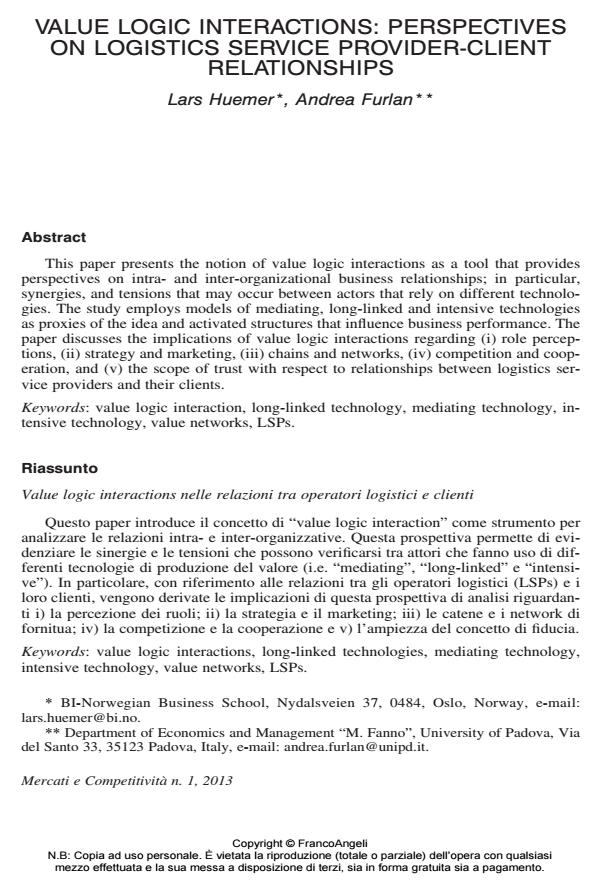Value logic interactions: perspectives on logistics service provider-client relationships
Titolo Rivista MERCATI E COMPETITIVITÀ
Autori/Curatori Lars Huemer, Andrea Furlan
Anno di pubblicazione 2013 Fascicolo 2013/1
Lingua Inglese Numero pagine 17 P. 35-51 Dimensione file 579 KB
DOI 10.3280/MC2013-001004
Il DOI è il codice a barre della proprietà intellettuale: per saperne di più
clicca qui
Qui sotto puoi vedere in anteprima la prima pagina di questo articolo.
Se questo articolo ti interessa, lo puoi acquistare (e scaricare in formato pdf) seguendo le facili indicazioni per acquistare il download credit. Acquista Download Credits per scaricare questo Articolo in formato PDF

FrancoAngeli è membro della Publishers International Linking Association, Inc (PILA)associazione indipendente e non profit per facilitare (attraverso i servizi tecnologici implementati da CrossRef.org) l’accesso degli studiosi ai contenuti digitali nelle pubblicazioni professionali e scientifiche
This paper presents the notion of value logic interactions as a tool that provides perspectives on intra- and inter-organizational business relationships; in particular, synergies, and tensions that may occur between actors that rely on different technologies. The study employs models of mediating, long-linked and intensive technologies as proxies of the idea and activated structures that influence business performance. The paper discusses the implications of value logic interactions regarding (i) role perceptions, (ii) strategy and marketing, (iii) chains and networks, (iv) competition and cooperation, and (v) the scope of trust with respect to relationships between logistics service providers and their clients.
Questo paper introduce il concetto di "value logic interaction" come strumento per analizzare le relazioni intra- e inter-organizzative. Questa prospettiva permette di evidenziare le sinergie e le tensioni che possono verificarsi tra attori che fanno uso di differenti tecnologie di produzione del valore (i.e. "mediating", "long-linked" e "intensive"). In particolare, con riferimento alle relazioni tra gli operatori logistici (LSPs) e i loro clienti, vengono derivate le implicazioni di questa prospettiva di analisi riguardanti i) la percezione dei ruoli; ii) la strategia e il marketing; iii) le catene e i network di fornitua; iv) la competizione e la cooperazione e v) l’ampiezza del concetto di fiducia.
Parole chiave:Value logic interaction, long-linked technology, mediating technology, intensive technology, value networks, LSPs
- Ballou R.H., Gilbert S.M. and Mukherjee (2000). A. New managerial challenges from supply chain opportunities. Industrial Marketing Management, 29: 7-18. DOI: 10.1016/S0019-8501(99)00107-8
- Baraldi E. and Waluszewski A. (2005). Information technology at IKEA: an “open sesame” solution or just another type of facility?. Journal of Business Research, 58(9): 1251-1260. DOI: 10.1016/j.jbusres.2003.05.001
- Bygballe, L. and Jahre M. (2009). Balancing value creating logics in construction. Construction Management & Economics, 27(7): 695-704. DOI: 10.1080/01446190903096609
- Christopher M. (1998). Logistics and Supply Chain Management: Strategies for Reducing Cost and Improving Service. London: Financial Times & Pitman Publishing
- Dewar R. and Rao H. UPS (2006). Supply chain solutions, Kellogg School of Management. Case KEL 177
- Ciabuschi F., Perna A. and Snehota I. (2012). Assembling resources when forming a new business. Journal of Business Research, 65(2): 220-229. DOI: 10.1016/j.jbusres.2010.11.029
- Dubois A., Hulthén K. and Pedersen A-C. (2004). Supply chains and interdependence: a theoretical analysis. Journal of Purchasing and Supply Management, 10(1): 3-9. DOI: 10.1016/j.pursup.2003.11.003
- Gadde L-E. and Håkansson H. (2001). Supply Network Strategies, Chichester: Wiley
- Håkansson H. and Ford D. (2002). How should companies interact in business networks?. Journal of Business Research, 55(2): 133-139. DOI: 10.1108/09574090410700202
- Håkansson H. and Persson G. (2004). Supply chain management: The logic of supply chains and Networks. International Journal of Logistics Management, 15(1): 11- 26. DOI: 10.1108/09574090410700202
- Håkansson, H. and Snehota I. (1989). No Business is an Island. Scandinavian Journal of Management, 5(3): 187-200. DOI: 10.1016/0956-5221(89)90026-2
- Håkansson H. and Waluszewski A. (2002). Managing technological development: IKEA, the environment and technology, London: Routledge. DOI: 10.4324/9780203217535
- Huemer L. (2012). Unchained from the chain: Supply management from a Logistics Service Provider Perspective. Journal of Business Research, 65(2): 258-264. DOI: 10.1016/j.jbusres.2011.05.028
- Huemer L. (2006). Supply Management: Value creation, coordination and positioning in supply relationships. Long Range Planning, 39(2): 133-153. DOI: 10.1016/j.lrp.2006.04.005
- Johansen C.F. and Skar S.T. (2012).Caught in Between Different Value Creation Logics: The Influences, Synergies and Tensions in Value Logic Interactions: A value configuration analysis of Tollpost. Globe AS. M.Sc. thesis, Norwegian Business School.
- Juga J., Pekkarinen S. and Kilpala H. (2008). Strategic positioning of logistics service providers. International Journal of Logistics: Research and Applications, 11, 443- 455. DOI: 10.1080/13675560802373472
- Ketchen D.J. Jr. and Hult G.T.M. (2007). Bridging organization theory and supply chain management: The case of best value supply chains. Journal of Operations Management, 25: 573-580. DOI: 10.1016/j.jom.2006.05.010
- Langley J.C., Dort E.V., Morton J., Hoemmken S., Goh A., Zabawa M., Strata R. and Riegler M. (2007). Third-Party Logistics: Results and Findings of the 12th Annual Study. Atlanta: Georgia Tech Supply Chain & Logistics Institute
- Løwendahl B.R. (2005). Strategic Management of Professional Service Firms. 3rd ed. Copenhagen Business School Press: Copenhagen
- Narayanan V.G. and Raman A. (2004). Aligning incentives in supply chains. Harvard Business Review, 82(11): 94-102
- Normann R. (2001). Reframing business: When the map changes the landscape. Chichester: Wiley
- Normann R. and Ramirez R. (1993). From Value Chain to Value Constellation: Designing Interactive Strategy. Harvard Business Review, July-Aug.: 65-77.
- Olsen A. and Hatlemark R. (2012). Understanding value logic configuration and interaction in a collaborative dyad of logistics service providers. M.Sc. thesis, Norwegian Business School.
- Porter M.E. (1985). Competitive advantage. New York, NY: The Free Press
- Stabell C., Fjeldstad Ø.D. (1998). Configuring value for competitive advantage: on chains, shops and networks. Strategic Management Journal, 19(5): 413-437. DOI: 10.1002/(SICI)1097-0266(199805)19:5<413::AID-SMJ946>3.0.CO;2-C
- Sum C.-C., Teo C.-B. and Ng K.-K. (2001). Strategic logistics management in Singapore. International Journal of Operations & Production Management, 21, 1239- 1260. DOI: 10.1108/EUM0000000005926
- Thompson J.D. (1967). Organizations in action, McGraw-Hill, New York.
Lars Huemer, Andrea Furlan, Value logic interactions: perspectives on logistics service provider-client relationships in "MERCATI E COMPETITIVITÀ" 1/2013, pp 35-51, DOI: 10.3280/MC2013-001004